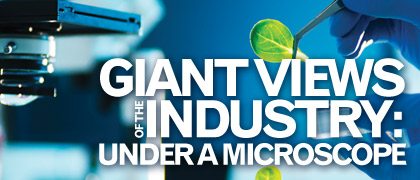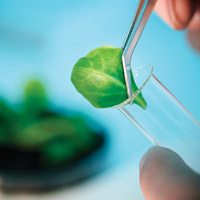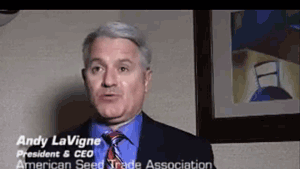As the rapid pace of technology continues to evolve seed innovations, and the importance of feeding a growing population puts agriculture front and center, old and new challenges in the seed industry are under a microscope on the world stage.
It’s a good time to be in agriculture, and particularly in seed: innovation is at an all-time high, and with a growing population it doesn’t look like that will slow down any time soon. If the seed industry is going to successfully feed a growing population in the years to come, it has a tall order: grow more with less. And the improvements in traits and genetics that are in the pipeline are truly exciting.
“This year refuge-in-a-bag is something that I see from a trait standpoint that’s really going to change the dynamics again of how farmers get access to genetics and technology. That trait coming on board in multiple, different technologies is going to be challenging but exciting for farmers, seed companies and the industry as a whole,” says Tim Johnson of Illinois Foundation Seeds.
While fierce competition within the industry remains, exciting new traits and genetics are also bringing the industry together like never before. Johnson says from the viewpoint of a product development and licensing and production company, he is excited for all potential customers, not just his company’s success. “When I look at genetics, obviously we’re excited about new products we’re bringing forward from our company, but there is also the excitement for each individual company—what’s important for their part of the business, their segment of the industry, their customer base. So we’re excited about where those opportunities are for people,” he adds.
Better use of water is another area of excitement for the industry and is extremely timely after the drought of 2012. “We are taking a multi-pronged approach to drought,” says John Soper of DuPont Pioneer. “Our AquaMax corn offering is really about utilizing native traits and utilizing our Accelerated Yield Technology and marker technologies to combine those native traits together to provide better drought tolerance solutions. But we also have biotechnology approaches—targeting genes that would impact drought tolerance at different stages of the life cycle.”
However, new technology brings with it new challenges and the seed industry is facing some of its biggest ones yet.
|
Biotechnology will play a critical role in the future when producing more with less. |
Bridging the GM Divide
“One of the biggest challenges—whether you are an individual seed company or the industry as a whole—is, ‘how do we best deploy the innovation that we have in front of us in an efficient manner?’” asks Norm Sissons of Monsanto.
He says in the seed industry there is typically a lot of fragmented market segments and a lot of unique needs within crops. “Being able to accomplish the economies of scale to develop the innovation, the technology that we have, and get an adequate return on that investment is a challenge,” he says. “Wherever we can look across the globe and make sense of segments that span the globe in different geographies that is definitely a help for our organization or for the industry as a whole.”
Many in the seed industry now agree that biotechnology will be critical in the future for producing more with less. “We all understand the importance of biotechnology, especially in corn, soybeans and cotton and what’s happened there in biotechnology,” says Scott Tefteller of Syngenta. “I think what drives [the development of GM crops] is the consumer. If you look at the population right now we’re at roughly an estimated seven billion people, and by 2050 we’ll be at nine billion people. We’ve got to employ the right technology in an efficient and sustainable way to fuel the growing demand for food,” says Tefteller. “If you look at some of the surveys done by the Council on Food, Agricultural and Resource Economics, the most recent survey, which was done in 2010, states consumers are ready for [GM vegetables].”
Kelly Keithly of Keithly-Williams Seeds agrees that biotechnology is a huge component to producing more with less. “Genetically modified vegetables have got to come so that we can increase the production, increase the quality and the flavor but also increase the ability of various varieties to be grown where it’s not compatible to try to grow them there today,” says Keithly. “Vegetables that take less water or that can get the water out of the ground easier and attributes like that, I think that’s going to come through GM varieties.”
Keithly says it is only a matter of time before these products hit the store shelves. “Six or seven years ago, I heard a speaker talk about how we’d be developing GM vegetables before the end of 2009, but just because of the consumer resistance we met due to people’s lack of understanding of what GM products are it hasn’t happened yet,” he says. “But they were resistant to trains back in the 1800s and resistant to automobiles and I think here again when we educate people about the value and the safety—they’ll buy into it.”
However, Sissons says there is still a long regulatory road ahead of GM vegetables which could limit their development. “When I think about the future of GM products in vegetables, I think it’s going to be pretty limited in terms of the number of products coming—at least in the near term,” says Sissons. “There are a couple of reasons for that. First off, when you think about developing and obtaining regulatory approval for a biotech event the cost is upwards of $50 million. From a vegetable seed standpoint that’s pretty restrictive because you either have to have a very high value product or you have to have very broad acres to make financial sense. As a result of that, I think the numbers of products that are going to meet the needs of broad acre or high value to make sense of the $50 million investment are going to be few and far between.”
“A good friend of mine once told me that good fences make good neighbors, meaning if you have a really good agreement then it provides a clear understanding of what’s expected on the part of both parties.”
— Ron Wulfkuhle
Licensing Concerns Linger
As technology and use of trait stacks continue, Johnson says the industry is going to start to see additional agreements with specific needs, uses and responsibilities. “Agreements will start to focus on certain niches—for example, when you look at the drought resistance products and how they fit, how you manage them, or how the output traits work for people—when people look at agreements for these type of products and how they’re defined, they just need to make sure they’re working within the parameters of those agreements and being responsible to those.”
Ron Wulfkuhle of GreenLeaf says when it comes to licensing agreements, “it’s almost certain that they’re going to get longer. A good friend of mine once told me that good fences make good neighbors, meaning if you have a really good agreement then it provides a clear understanding of what’s expected on the part of both parties. When you have that then you both understand how many resources you can invest, you understand how aggressive to be and you understand what reward you can count on at the end.”
Wulfkuhle says the reason agreements will get longer is simple: technologies are becoming more complex. “Many of the products we sell today cont
ain multiple components. We’re working on Agrisure Artesian, as an example, that has multiple alleles. We’re also working on multiple trait stacked products and with those come changing requirements, especially from a quality assurance standpoint,” he says. “So we always make sure—we call it E and E testing—that the trait is turned on and is functioning with good efficacy, and that the products are equivalent in yield in the absence of whatever pest that trait is trying to control. As a result, it takes some paper to explain that and to have a good agreement.”
Existing Together
With the increase of technology and the number of biotech traits coming into the marketplace, Andy LaVigne of the American Seed Trade Association says coexistence has become much more of a focus. “While coexistence has always been a core part of seed production, it is becoming increasingly more important, especially in Washington, D.C.,” says LaVigne. “We are working closely with the USDA following Secretary Vilsack’s reinstatement of the AC21 to look at the issue of coexistence between conventional, organic and biotech crops to limit negative impacts on one or the other. And then the question will become, ‘in what direction will the proposed policy recommendations lead?’”
LaVigne says this is an area that the seed industry needs to help the policymakers get right. “We all know that no biological system is 100 percent pure. Food production is not 100 percent—that’s Mother Nature. You always have natural impacts on our production processes,” he says. “So how do we limit potential negative impacts between cropping systems to enable producers to be successful in their efforts. Our efforts in this process are to provide input into the AC21 process about how the seed industry produces seed in ways that are based on coexistence in order to produce high-quality seed for all markets.”
Talking Trade
Another challenge of bringing on new innovation is how to minimize trade challenges such as phytosanitary requirements, low level presence and intellectual property protection. “Wherever we can minimize those challenges is going to really increase the pace of innovation in seed and really bring better solutions for seed growers around the globe,” says Sissons.
He says discussions within the industry are becoming more focused on the challenges of harmonizing regulations as much as possible and, “minimizing some of those non-tariff trade barriers where different jurisdictions decide to impose non-science-based restrictions. Wherever we can get to more of a science-based approach I think that’s really going to help in minimizing those restrictions.”
LaVigne says ASTA has been working hard on a number of trade issues that have a big impact on the ability of that movement of seed both into the United States and into other countries.
“In terms of phytosantary issues, we continue to work really closely with NAPPO in Canada, the United States and Mexico to essentially harmonize the requirements for pest risk analysis between the three countries and then harmonizing pest lists,” he says. “And, expanding on that, we continue to make progress with our activities with the Seed Association of the Americas from North to South America. We continue to focus on Brazil as they update their pest lists, working to make sure the lists are scientifically sound. Transparency in the development of the lists will be critical as we continue to see that increase in the movement of seed from North and South America.”
Low level presence is also on the radar, says LaVigne, and much progress has been made in the last year. “We continue working with NAPPO and South American countries,” LaVigne says. “Between Brazil, Argentina, Mexico, the United States and Canada, we produce 80 percent plus of all biotech crops globally, so our efforts with these countries are to help facilitate the issues on a global basis and ensure acceptance in the international arena.”
“In terms of phytosantary issues, we continue to work really closely with NAPPO in Canada, the United States and Mexico to essentially harmonize the requirements for pest risk analysis between the three countries and then harmonizing pest lists.” — Andy LaVigne
Food Safety Intensifies
Another area of importance that has been thrust into the spotlight with increased innovation, especially in the media, is food safety. “When somebody has an issue with food safety they stop eating [that food], when people stop eating certain vegetables or fruits then people stop buying seed. It really does have a devastating effect and we’re trying to play a much more active role in the food safety arena on the produce side,” LaVigne says. “There’s always a tie in, it never fails—we end up seeing a media release in which someone tries to associate the issue back to seed.”
LaVigne says the media and general public can be easily misguided, and the seed industry needs to stay on top of communicating the right message. “What we’ve seen most recently in the media is alfalfa sprouts—media talks about alfalfa seed instead of alfalfa sprouts. It automatically gets tied back to seed issues. So this is a really sensitive issue as we spend a great deal of time working with our colleagues, other organizations and seed groups to talk to the media about seed not being a carrier for these diseases. Also making sure that we gather all the information and scientific data available to justify our position on behalf of the industry,” he says.
Seed’s Story to Tell
Perhaps the biggest issue that seed faces is how to best communicate to government and the public how it is meeting, and exceeding, all of these challenges. “In agriculture, the people that we serve, that we grow food, fiber and even fuel for, don’t understand what agriculture is doing to serve this nation as well as the world,” says Keithly.
And he says it is the seed industry’s job to make sure that story is told right, a point that also comes back to the entire industry working together like never before. “We need to make sure the various state legislatures aren’t working against us, but rather work with us to enable us to do our job better. There’s coming a time here pretty quick when it’s going to be very tough to feed the population of this world and we’ve got to figure out how to do that and how to have our governments working with us to help us get that job done.”
Julie McNabb














